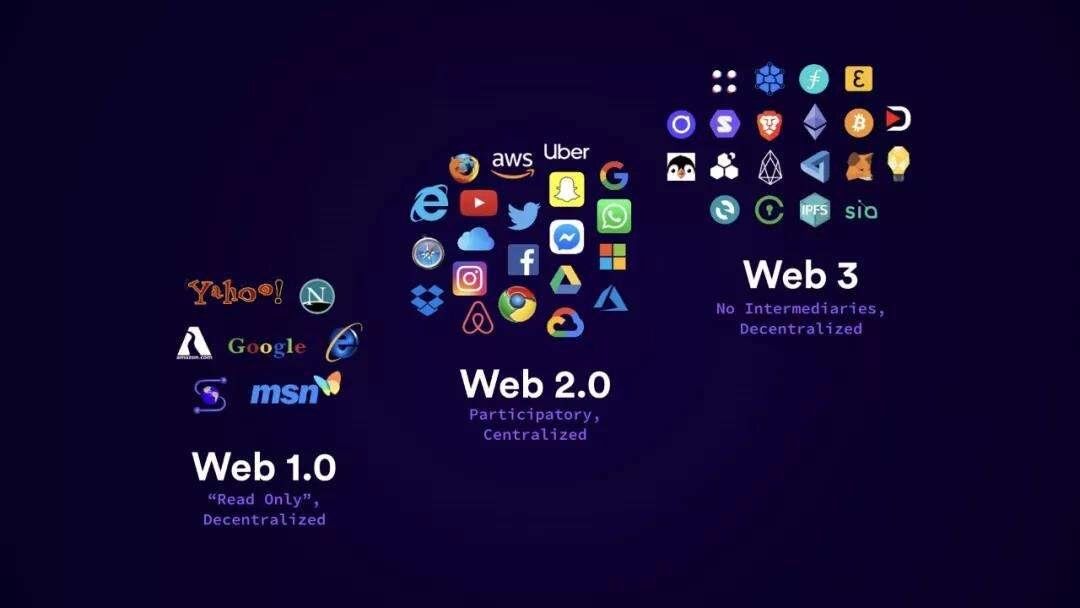As early-stage investors, we’re always noticing new trends and conversations in the tech community, and Web3 is one of those that keeps popping up. As we look into the sector, we wanted to share a few things we’re learning.
To understand where Web3 is going, we must first understand the evolution and where we came from.
Web1
With the initial creation of the Internet, people were able to access information at what was then called “lightening quick speed”. If you wanted to know what to do on a trip to Italy, you could open Internet Explorer, do a simple search, and have a sample itinerary within an hour or so. The internet was built to be open sourced so anyone could absorb and create content to educate, sell, and promote. With Web1, people could finally get access to what they wanted when they wanted it, but there was not much real-time interaction between the user and the creator. It is termed by some as the “read-only” version of the Internet.
Web1 Applications: AOL, Internet Explorer, Yahoo!, Company-created websites & catalogs, and Google.
Web2
Web2 introduced platforms and applications that users can interact with and is essentially the version of the Internet that most of us are familiar with today. Not only can we search for “Things to do in Italy”, but we can instantly book tours, flights, hotels, and more with one click. We can also watch other travelers’ YouTube videos, join a “Travel to Italy” Facebook group to chat with people who are also taking a trip, or even take virtual tours of Italy from our living room. The experience doesn’t stop after we’ve booked through the website as we’ll be continually fed recommendations of similar experiences and products via email or targeted ads long after we leave the website.
Web2 Applications: Amazon, Facebook, Twitter, Robinhood, Airbnb, Reddit

Platforms and applications in Web2 have boosted innovation and have made life much easier for many people. However, many have also become extremely dependent on these applications. For example, I can’t remember the last time I booked a flight without going to Kayak to check for the best rates. And when I need a simple household item I check Amazon first.
The problem is, when these large companies need a slight edge over their competitors, they resort to the “oil” that can give them an advantage - data. Our own information and behavior has been collected and used to influence our thinking and actions, and usually we don’t even realize it.
Additionally, many leading Web2 companies have a lot of power. Early this year, when Robinhood shut down trading on its platform for millions of retail investors, it created questions around consumer rights. Apps like Twitter can block content or revoke account access if they deem something to be “inappropriate”. But by whose standards? Can we actually say we own an asset - be it cash or real estate - if we have to go through intermediaries to sell it or send it?
Are we trapped?
Enter Web3 - the future of the Internet.
The goal of the Web3 ecosystem is to make the internet as accessible, open-sourced, secure, and decentralized as possible. The idea is that protocols in a Web3-based environment should benefit the people engaging with them, not central organizations. The theory is that every platform and application you see in Web2 today will have a Web3 equivalent. The difference will be that the Web3 versions will be based on the blockchain - a decentralized, distributed, and oftentimes public, digital ledger. The Web3 ecosystem consists of decentralized applications (DApps), decentralized finance (DeFi), non-fungible tokens (NFTs), Decentralized Autonomous Organizations (DAOs), cryptocurrencies, and more.
Web3 Applications: OpenSea, MetaMask, BlockFi, Gemini, Chainalysis.
The benefit of Web3 is multifold:
- The platforms and applications in Web3 are natively neutral. Contracts between the users and the crypto networks that these platforms are built upon are all open-sourced.
- In Web3, the community has a voice. Features or partnerships are inspired by what users want and users will be the ones to influence what changes take place on the platform - not a centralized entity.
We’ve broken down the broader space into three areas we think will see the most growth:
- The application stack
- Support around the application stack
- Community-driven platforms
The application stack (DApps, Defi, Insurance, Lending)
There will be endless opportunities to create, invest in, or be an early adopter of the next generation of unicorn Web3 application companies. We believe that every app consumers interact with on a daily basis today will have a Web3 equivalent in the future which is safer, quicker, and frankly better than what’s out there currently. These apps will likely have a very similar look and feel to the ones we use today, but will run on blockchain networks in the background.
Companies like Gemini and Dapper Labs have already seen huge growth due to their consumer-first nature. We’re still in the early days of making the crypto / NFT onboarding process consumer friendly so there is a lot of opportunity. A good example is to think about what Amazon did for Web2 - opening up a global catalog and opportunity to transact on the spot through one platform - apply similar principles while thinking about opportunities for Web3 apps. Additionally, sectors like supply chain and healthcare have new potential when it comes to leveraging decentralization.
Support around the application stack (Security, Data Infrastructure, Backend Payment Processing)
Once Web3 applications are built and become mainstream, there will need to be software to support them. You can think about it like a car - you need gas to fuel it, a wash to shine it, and a periodic oil change to keep it moving.
For example, with scale comes natural security issues. We saw this with Web2 and we will surely see it in Web3. Security incidents may not be as frequent (as the whole premise of the blockchain is for it to be secure), but we will undoubtedly see breaches, loss of digital assets, and other security vulnerabilities. Companies like Chainalysis were created to solve some initial security challenges exchanges and DApps are facing, but there are plenty of Web3 security companies yet to be built. Adjacent areas such as insurance and data cleansing will also require solutions as adoption increases.
Community-driven platforms (Consumer Social, DAOs, NFT Marketplaces)
Near-term, there will be platforms that are successful primarily because of the community around them. We’ve seen this already with tokenized companies like Decentraland and Theta Labs (a Sierra Portfolio Company). Since Web3 puts users back in charge, anything users want and are willing to consume creates opportunities for new businesses.
NFT marketplace OpenSea as an example, has nearly $4B in monthly transaction volumes. Gaming, trading, collectibles, e-sports, and social are all areas ripe for disruption. That being said, we’ve yet to see a mainstream “Github for Web3” or “Reddit for Web3”. Building community-driven platforms will require a two phased product market fit process: 1) finding developers to build out the community and innovate on the platform without many rewards initially; and 2) users to adopt and continuously engage. A company solving these issues would likely become a big company!
Check out more Insights from the Sierra Ventures Team.
Read other Tech Trends.

